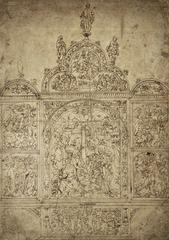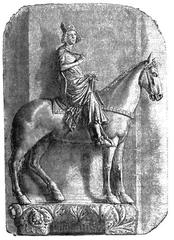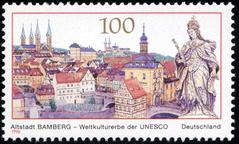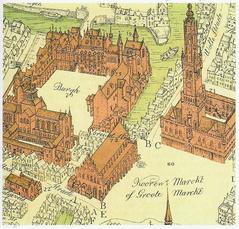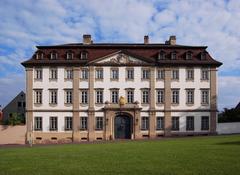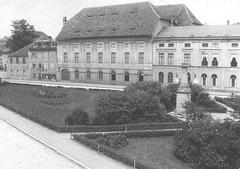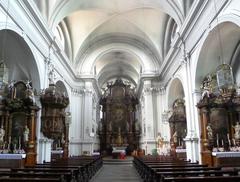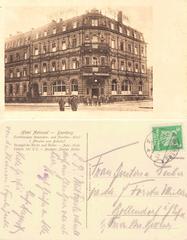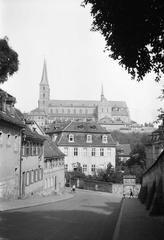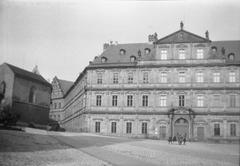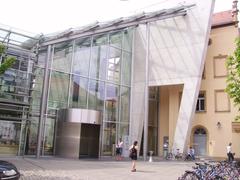Stadtvilla Bamberg: Visiting Hours, Tickets, and Historical Site Guide
Date: 14/06/2025
Introduction: Bamberg’s Stadtvilla and Its Cultural Significance
Located in the heart of Bamberg, Germany, the Stadtvilla is a symbol of the city’s rich architectural and cultural heritage. These stately urban villas offer visitors a window into the lifestyles of Bamberg’s affluent citizens of the late 19th and early 20th centuries. As part of a city whose Old Town has been recognized as a UNESCO World Heritage Site since 1993, the Stadtvillas exemplify Bamberg’s evolution from a medieval bishopric to a modern urban center. With their ornate facades, spacious interiors, and often lush gardens, Stadtvillas reflect the prosperity of Bamberg’s bourgeoisie during the era of industrial and cultural expansion (Nomads Travel Guide; UNESCO; PlanetWare).
This guide provides detailed historical context, architectural analysis, and practical visitor information for exploring Bamberg’s Stadtvillas, including hours, ticketing, accessibility, and nearby attractions. Whether you are planning a day visit, an overnight stay in a boutique villa hotel, or participation in cultural activities, this resource will help you appreciate the living heritage of Bamberg (Bamberg Info; Germany Travel; Explorial).
Table of Contents
- Bamberg’s Historical Context
- Stadtvilla in Bamberg: Historical and Architectural Overview
- Cultural Significance and Visitor Experience
- Visiting Stadtvilla Bamberg: Hours, Tickets, and Attractions
- Practical Information and Travel Tips
- Frequently Asked Questions (FAQ)
- References and Further Resources
1. Bamberg’s Historical Context
Medieval and Early Modern Origins
Bamberg’s origins can be traced to 902 AD, its strategic position at the confluence of the Regnitz and Main rivers shaping its role as a crossroads for trade and culture (Nomads Travel Guide). In 1007, Emperor Henry II established the bishopric of Bamberg, envisioning it as a spiritual and political stronghold. The foundation of Bamberg Cathedral, with its iconic four towers and royal tombs, underscored the city’s imperial connections (Nomads Travel Guide). Through the 12th and 13th centuries, Bamberg blossomed under the rule of prince-bishops, accumulating wealth and autonomy within the Holy Roman Empire (Discover Walks).
Renaissance to Baroque Transformation
The 16th century saw Bamberg maintain its Catholic identity amid the Reformation, leading to tension but also a surge in ecclesiastical and civic architecture (Nomads Travel Guide). The 17th and 18th centuries marked a baroque renaissance, with grand projects like the Neue Residenz and Bamberg State Library showcasing the city’s opulence (Joey is a Traveler). Bamberg’s topography of seven hills, each crowned with a church, earned it the moniker “Franconian Rome” (Discover Walks).
Modernization and Preservation
Secularization in 1802 ended Bamberg’s ecclesiastical independence, integrating it into the Kingdom of Bavaria. The arrival of the railway in 1844 spurred economic development, yet the city maintained a strong preservation ethos (Nomads Travel Guide). Minimal damage during the World Wars allowed Bamberg to retain its architectural integrity (Europe Up Close). In 1993, Bamberg’s old town received UNESCO World Heritage status, recognized for its exceptional preservation and influence on European urban development (UNESCO).
2. Stadtvilla in Bamberg: Historical and Architectural Overview
What is a Stadtvilla?
A “Stadtvilla” is an urban villa or stately townhouse, typically constructed for wealthy citizens in the 19th and early 20th centuries. In Bamberg, Stadtvillas are found in neighborhoods that expanded with the city’s modernization, their elegant facades and manicured gardens reflecting bourgeois tastes (The Invisible Narad).
Architectural Features
Stadtvillas in Bamberg showcase neoclassical, historicist, and Jugendstil (Art Nouveau) influences—ornate stucco, high ceilings, grand staircases, and large windows are common. Many have been repurposed as boutique hotels, cultural venues, or guesthouses, allowing visitors to experience their historic ambiance (Immobilienanalyse Bamberg).
Urban Integration and Preservation
Set among winding medieval streets, Stadtvillas blend private grandeur with public accessibility. Strict conservation guidelines help maintain their character, with many adapted for modern uses that support sustainable tourism (The Invisible Narad).
3. Cultural Significance and Visitor Experience
Spiritual and Artistic Heritage
Bamberg was envisioned as a spiritual center by Emperor Henry II and later flourished as a hub for Enlightenment thinkers, artists, and musicians (UNESCO). Stadtvillas often hosted salons and gatherings for intellectuals and cultural figures.
Urban-Agricultural Tradition
The Gärtnerstadt (Gardeners’ District) showcases Bamberg’s unique mix of urban and agricultural traditions, with Stadtvillas often featuring lush gardens and courtyards (worldheritagesites.net). Local museums and walking tours offer insights into this living heritage.
Events and Living Traditions
Bamberg’s calendar brims with festivals, concerts, and exhibitions—many staged in or near Stadtvillas. Culinary traditions, such as sampling Rauchbier (smoked beer) and Franconian specialties, are integral to the city’s identity (Germany Travel; wanderingermany.com).
Accessibility
The city center is highly walkable and pedestrian-friendly. Many Stadtvillas are accessible, but visitors with mobility needs should check facilities in advance (worldheritagesites.net).
4. Visiting Stadtvilla Bamberg: Hours, Tickets, and Attractions
Hours and Admission
- Visiting Hours: Most public Stadtvillas are open 10:00 AM–6:00 PM, Tuesday through Sunday; closed Mondays and some holidays. Boutique hotels have check-in from 2:00 PM and check-out by 11:00 AM (Bamberg Info).
- Tickets: Entry to museums or cultural Stadtvillas ranges from €5–€12. Garden entry is often free; guided tours may require a fee.
- Booking: Advance booking for accommodation or guided tours is recommended during high season.
What to See and Do
- Architectural Tours: Explore original features, lush gardens, and period furnishings.
- Art Exhibitions: Venues like Villa Dessauer host rotating contemporary exhibitions (Villa Dessauer Art Gallery - PlanetWare).
- Culinary Experiences: Dine on regional specialties in villa restaurants or cafés (Franconian Cuisine at Stadtvillas - Sommertage).
- Workshops & Events: Attend workshops, seasonal garden parties, and music events.
- Photography: Early morning and sunset offer the best light for photos of facades and gardens (Bamberg Photography Spots - Tourist Secrets).
Accessibility & Facilities
- Mobility: Many Stadtvillas have ramps or elevators; details vary, so confirm in advance.
- Dining: Breakfast often included with stays; numerous restaurants are nearby (Nomadic Samuel).
- Parking: Limited in the Old Town; book private parking with your villa or use public garages.
Nearby Attractions
Combine your visit with Bamberg Cathedral, Old Town Hall, Rose Garden, and Little Venice. Walking tours often include Stadtvillas and key city landmarks (PlanetWare).
5. Practical Information and Travel Tips
- Getting There: Bamberg Hauptbahnhof is 1.5 km from the Old Town; walk, take a bus, or taxi (Time Travel Turtle).
- Accommodation: Book early for peak periods. Rooms range €90–€180/night. Amenities typically include Wi-Fi, breakfast, and bike rentals.
- Transport: Old Town is best explored on foot; local buses and bikes are available.
- Weather: Best visited late spring to early autumn; June average temperatures are 11–23°C (Bamberg Weather in June - Wanderlog).
- Sustainability: Use public transport, walk, or cycle; respect local quiet hours (10:00 PM–6:00 AM); recycle waste (Germany Footsteps).
- Safety: Bamberg is safe; standard precautions apply. Emergency numbers: 112 (medical/fire), 110 (police).
- Language & Currency: German is the official language; English is widely spoken in tourism. Currency is Euro (€).
6. Frequently Asked Questions (FAQ)
Q: What are the typical visiting hours for Stadtvilla Bamberg?
A: 10:00 AM to 6:00 PM, Tuesday–Sunday for public venues; boutique hotels have check-in from 2:00 PM.
Q: Do I need tickets to visit?
A: Yes, for museums or cultural venues (€5–€12). Accommodation requires booking.
Q: How accessible are Stadtvillas?
A: Many are partially accessible; check with the specific villa in advance.
Q: Where can I park?
A: Limited private parking or public garages at the Old Town’s edge; reserve ahead if possible.
Q: Are guided tours available?
A: Yes, through local operators and the tourist office. Advance booking is recommended.
Q: Can I combine a visit with other attractions?
A: Absolutely—Stadtvillas are near Bamberg Cathedral, Old Town Hall, and other sites.
7. References and Further Resources
- Nomads Travel Guide
- UNESCO
- Germany Travel
- PlanetWare
- Bamberg Info
- Discover Walks
- Tourist Secrets
- The Invisible Narad
- Immobilienanalyse Bamberg
- bamberg.info
- Sommertage
- Time Travel Turtle
- Nomadic Samuel
- Germany Footsteps
Enjoy your exploration of Bamberg’s Stadtvillas—where history, architecture, and culture meet. For more travel tips, download the Audiala app and follow us on social media for up-to-date event information and guides.

